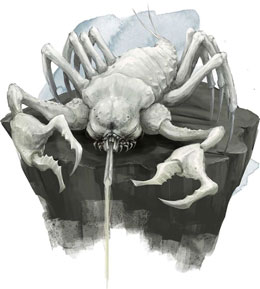By Alan McCoy from Dungeons & Dragons: Fundamentals
How to build challenging
encounters against a Cave Fisher
Note: This has been prepared utilizing only the 5E Core Rules. The Cave Fisher can be found in Volo’s Guide to Monsters page 130.
The cave fisher is a subterranean arachnid with a long snout. It produces a sticky filament that the fisher uses to snag prey.
The cave fisher usually hunts small animals and bats; thus, it usually drapes its filament over openings that its instincts tell it such prey uses. After setting the trap, the fisher climbs to a high hiding spot and adheres itself to that surface to rest and wait. When prey blunders into the filament, the cave fisher reels in the unlucky prey.
While normally solitary or in small groups, there are areas in which communities of these creatures drape huge areas with webbing.
Cooperation only goes so far; the members of the community are likely to fight over the prey. While normally found only in caves, there have been isolated reports of these creatures inhabiting shadowy canyons and gloomy forests.
Step 1) Determine the probable Strategy.
The cave fisher is an instinctual hunter, it waits for prey much like a spider in its web, except that in this case the web is only a single strand.
Cave fishers are instinctually wary of larger prey and will cut their webbing and avoid attacking humanoids unless it comes upon a solitary target. In general, the strategy of the cave fisher is much like any fisherman, toss out your line and wait and see.
Step 3) Determine Tactics
The cave fisher is covered in a tough chitin carapace. it is extremely strong and tough, and nimble on the move. It has a solid self-preservation instinct and will avoid prey that might harm it. It can move 20 feet and Climb 20 feet. It is not disturbed by difficult terrain.
The first part of Cave Fisher Tactics is to find a High Hide. A high place that offers some concealment from which the fisher can hang its filament and rest in reasonable safety. Fishers have +5 to stealth checks, so available concealment will enhance that further.
The high hide needs to be high enough that prey the prey can dangle freely, with no purchase upon which to resist the pull, exhausting itself with the effort.
Once a satisfactory high hide is found the fisher will drape the area with nearly invisible trip webs which it uses to catch prey. These tripwires require a passive perception of 15 or better to spot.
The first creature entering a square in which trip webs have been placed will be caught. Cave fishers instinctively clear away any fallen evidence of previous victims, so you might give alert characters a chance of spotting a ‘clean/clear’ zone.
The ‘fishing’ line requires a DC 13 Strength check to break.
Once prey is caught, the fisher will begin reeling in its prey, instinctually it is going for roughly twenty feet off the ground. As a Size M creature with a 16 Strength, the fisher can lift up to 480 lbs. However, any more than 240 lbs., drops lift speed to a mere 5 feet/round. (PHB page 176).
Once at the 20-foot mark the cave fisher will let the load hang, expecting the prey to struggle and exhaust itself. If the fisher senses that the load is very heavy or strongly struggling, it can fasten off the current line and extend a second line with its Adhesive Filament ability.
I suggest that you adjust the ‘chase’ rules provided in Xanathar’s Guide to Everything, (Every 3 consecutive rounds spent dashing = DC 10 Con Save or apply a level of Exhaustion) or in this case every 3 consecutive rounds spent struggling = DC 10 Con Save or apply a level of Exhaustion.
Whenever the prey stops struggling the fisher will begin reeling. The fisher will instinctually raise and lower the prey several times to ensure that it is motivated to escape and exhausts itself. This is the ‘Fishing’ action that the creature is named for.
Excessively heavy prey, over 240 lbs. is considered dangerous to the fisher, often they will drop such prey from a height of 30 feet or more, intentionally injuring the prey and making it harder to climb up to pursue.
Once the prey is sufficiently exhausted, the fisher will reel it to within five feet where it can bring its powerful claws into bear. using its multi-attack to rend the prey into consumable chunks.
If a cave fisher is successfully attacked and reduced to half of its hit points or lower, the blood of the fisher is flammable, and the creature will be rendered vulnerable to fire damage.
